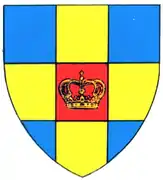Ținutul Mureș
Ținutul Mureș (or Ținutul Alba Iulia) was one of the ten ținuturi ("lands") of Romania, founded in 1938 after King Carol II initiated an institutional reform by modifying the 1923 Constitution and the law of territorial administration. It comprised most of Transylvania, and included parts of the Székely Land. Its capital was the city of Alba-Iulia. Ținutul Mureș ceased to exist following the territorial losses of Romania to Hungary and the king's abdication in 1940.
Ținutul Mureș
Ținutul Alba Iulia | |
|---|---|
Land (Ținut) | |
 Coat of arms | |
 | |
| Country | |
| Historic region | Transylvania |
| Capital city (Reședință de ținut) | Alba-Iulia |
| Established | The administrative reform of 1938 |
| Ceased to exist | Territorial loss and new administrative law (30 August 1940) |
| Government | |
| • Type | Rezident Regal |
| Time zone | UTC+2 (EET) |
| • Summer (DST) | UTC+3 (EEST) |
Coat of arms
The coat of arms is party per cross in 9 equal squares, representing the former 9 counties (ținuturi) of Greater Romania (71 in total) which it had included. Four of the squares, forming the arms of a Greek cross, are of or. The four squares forming the corners of the shield are of azure. The square in the heart of the shield is gules, and bares an or Romanian Crown (in recollection of the 1922 Alba-Iulia coronation of Ferdinand I and Marie of Edinburgh as King and Queen of Greater Romania).
Former counties incorporated
After the 1938 Administrative and Constitutional Reform, the previous 71 counties lost their authority.
- Alba County
- Ciuc County
- Făgăraș County
- Mureș County
- Năsăud County
- Odorhei County
- Sibiu County
- Târnava Mare County
- Târnava Micǎ County
In 1939 Năsăud County was ceded to Ținutul Crișuri in exchange for Turda County.